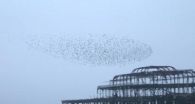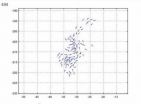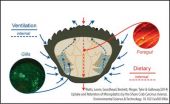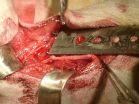(Press-News.org) The mystery behind the movements of flocking starlings could be explained by the areas of light and dark created as they fly, new research suggests.
The research, conducted by the University of Warwick and published in the journal PNAS, found that flocking starlings aim to maintain an optimum density at which they can gather data on their surroundings. This occurs when they can see light through the flock at many angles, a state known as marginal opacity. The subsequent pattern of light and dark, formed as the birds attempt to achieve the necessary density, is what provides vital information to individual birds within the flock.
The dynamic pattern of light and dark is created by birds within the flock altering the positions and angles at which they fly, causing a change in the amount of light let into the flock. The researchers observed that it was always possible to see areas of light coming through the flock, providing the initial insight that the changing patterns of light and dark had a role to play in the flock's movement.
This insight led to the development of a computer model in which individual birds with simulated intelligence were attracted to the areas in the flock that could provide the most information on the rest of the flock . When each simulated bird was attracted to the areas in the virtual flock that can provide the most information the result was a cohesive swarm.
The Warwick team then applied the model's findings to flocks in the wild and established that there was a strong correlation between movements of the virtual and natural birds.
"An individual starling within a flock can see in front of them areas of light and dark created by other birds, forming a dynamic and changing silhouette", says lead researcher Daniel Pearce from the University's Department of Physics. "Our research ascertained that the silhouettes we external observers witness were a result of large flocks self-organising to achieve a marginally opaque state at which a bird can still see some of the light sky through gaps in the flock and gather information from other birds.
"When we observe a flock of starlings we are actually seeing a 2D projection of a dynamic, changing 3D environment. By developing this model we have been able to simulate this environment and see that when each bird is attracted to the areas in the flock that can provide the most information the result is a cohesive swarm that resembles a large flock of starlings in the wild", comments Mr Pearce.
It had previously been thought that co-ordination of a flock was achieved through birds interacting only with neighbouring members but, argues Professor Emeritus and paper co-author George Rowlands, the new research marks "a paradigm shift in our understanding of how birds organise within a flock as it shows that the local interactions between birds are alone insufficient to explain large-scale flock organisation".
INFORMATION:
Footnote and Notes to editor:
1. "We use a technique called agent based modelling of self-propelled particles, made famous by Vicsek et al (1995). Each bird is represented by a particle which each have an identical set of rules to follow (and likelihood of making a mistake). In this case the rules are a) follow your nearest neighbour and b) move towards the areas of the projection containing the most information. When lots of these particles are introduced, the result is a collective motion much like that of a real flock of birds", says Mr Pearce.
Video of the computer model and the virtual flock: http://www.youtube.com/watch?v=QPZbedm_fBA
Copy of the paper, Role of projection in the control of bird flocks, can be found here: http://www.pnas.org/content/early/2014/07/03/1402202111.abstract?sid=3b1b700b-b503-4d9d-9885-e7c31f5178f3
Photos and video available of starlings flocking over Brighton Pier, which were collected as part of the research, are available on request – a.t.frew@warwic.ac.uk
Interactive simulated flocks used in the research can be viewed and tested here: http://www2.warwick.ac.uk/fac/sci/moac/people/students/2009/daniel_pearce/phd/projsim/#
This work was partially funded by the UK Engineering and Physical Sciences Research Council through the MOAC and Complexity Doctoral Training Centres.
Revealed: The mystery behind starling flocks
2014-07-18
ELSE PRESS RELEASES FROM THIS DATE:
Adults with eosinophilic esophagitis should consider a diet change
2014-07-18
Bethesda, MD (July 18, 2014) — Dietary elimination is a successful method of treatment for adults with eosinophilic esophagitis (EoE), according to a new study1 in Clinical Gastroenterology and Hepatology, the official clinical practice journal of the American Gastroenterological Association.
"By eliminating specific foods from patients' diets, symptoms improved in 71 percent of patients, and endoscopic appearance improved in 54 percent," said lead study author, W. Asher Wolf, MD, MPH, and co-author Evan S. Dellon, MD, MPH, from the division of gastroenterology and hepatology, ...
Genetic variations may modify cardiovascular benefit of aspirin
2014-07-18
BOSTON – Aspirin is the gold standard for antiplatelet therapy and a daily low-dose aspirin is widely prescribed for the prevention of cardiovascular disease.
Now, a new study suggests that common genetic variation in the gene for catechol-O-methyltransferase (COMT) may modify the cardiovascular benefit of aspirin, and in some people, may confer slight harm. The findings, led by investigators at Beth Israel Deaconess Medical Center (BIDMC) and Brigham and Women's Hospital (BWH) appear online in the American Heart Association journal Arteriosclerosis, Thrombosis, and ...
Microplastics worse for crabs and other marine life than previously thought, study shows
2014-07-18
The tiny plastic particles polluting our seas are not only orally ingested by marine creatures, but also enter their systems through their gills, according to a new study led by the University of Exeter.
Scientists also discovered that when microplastics are drawn in through this method they take over six times longer to leave the body compared with standard digestion.
Lead author Dr Andrew Watts of the University of Exeter said: "Many studies on microplastics only consider ingestion as a route of uptake into animals. The results we have just published stress other ...
The bend in the Appalachian mountain chain is finally explained
2014-07-18
The 1500 mile Appalachian mountain chain runs along a nearly straight line from Alabama to Newfoundland—except for a curious bend in Pennsylvania and New York State. Researchers from the College of New Jersey and the University of Rochester now know what caused that bend—a dense, underground block of rigid, volcanic rock forced the chain to shift eastward as it was forming millions of years ago.
According to Cindy Ebinger, a professor of earth and environmental sciences at the University of Rochester, scientists had previously known about the volcanic rock structure under ...
Immune cell's role in intestinal movement may lead to better understanding of IBS
2014-07-18
Learning the role of immune-system cells in healthy digestive tracts and how they interact with neighboring nerve cells may lead to new treatments for irritable bowel syndrome (IBS). Researchers from Penn State College of Medicine, in collaboration with other scientists, have reported the role of macrophages in regulating the contractions of the colon to push digested material through the digestive tract.
The muscular lining of the intestine contains a distinct kind of macrophage, an immune system cell that helps fight infections. The role of these cells in normal colon ...
It's go time for LUX-Zeplin dark matter experiment
2014-07-18
New Haven, Conn. -- From the physics labs at Yale University to the bottom of a played-out gold mine in South Dakota, a new generation of dark matter experiments is ready to commence.
The U.S. Department of Energy's Office of Science and the National Science Foundation recently gave the go-ahead to LUX-Zeplin (LZ), a key experiment in the hunt for dark matter, the invisible substance that may make up much of the universe. Daniel McKinsey, a professor of physics, leads a contingent of Yale scientists working on the project.
"We emerged from a very intense competition," ...
Improving driver safety: How to prevent streetlight glare in the new world of LED lighting
2014-07-18
WASHINGTON, July 18—Long hours of nighttime driving can cause eyestrain because while our vision adapts to the surrounding darkness, the sudden stabs of brightness from streetlamps can be irritating, distracting and even painful. Even as LED technology has transformed the lighting industry, bringing the promise of more energy-efficient road illumination, some fear that the new lights could cause even more troublesome, unsafe glare.
A team of researchers from China and the Netherlands has developed a way to evaluate the human impact of uncomfortable glare caused by LED ...
NASA sees super typhoon Rammasun eyeing landfall
2014-07-18
Imagery from NASA's Aqua satellite captured a wide-eyed Typhoon Rammasun as it was making landfall in northern Hainan Island, China early on July 18. A rainfall analysis using another NASA satellite showed the flooding potential of the storm as it left the Philippines and headed for China. Now, Rammasun is headed for a final landfall near the northeastern border of Vietnam and China.
On July 17, an analysis of Typhoon Rammasun's rainfall was conducted at NASA's Goddard Space Flight Center in Greenbelt, Maryland. The rainfall analysis covered the storm's rainfall from ...
NASA satellite catches birth of Tropical Storm Wali near Hawaii
2014-07-18
The first tropical cyclone of the season has formed in the Central Pacific Ocean as NASA's Terra satellite passed overhead. Tropical Storm Wali formed southeast of the Big Island of Hawaii, and now that it's nearing, a Flash Flood Watch has been posted for all of the islands.
NASA's Terra satellite passed over Wali on July 17 at 19:55 UTC (3:55 p.m. EDT) just as it was being classified as Tropical Depression 1C. NOAA's Central Pacific Hurricane Center (CPHC) issued an advisory at 5 p.m. EDT (11 a.m. HST) announcing the birth of the depression near 12.7 north and 140.7 ...
A rhesus monkey model of radial nerve injury for evaluating peripheral nerve repair
2014-07-18
Current research on bone marrow stem cell transplantation and autologous or xenogenic nerve transplantation for peripheral nerve regeneration has mainly focused on the repair of peripheral nerve defects in rodents. Dr. Dong Wang and his team, First Affiliated Hospital of Sun Yat-sen University, China established a standardized experimental model of 2.5 cm-long radial nerve defects in rhesus monkeys and evaluated the effect of repair on peripheral nerve injury. The quality of nerve regeneration in the bone marrow stem cells-laden allografts was comparable to that achieved ...








